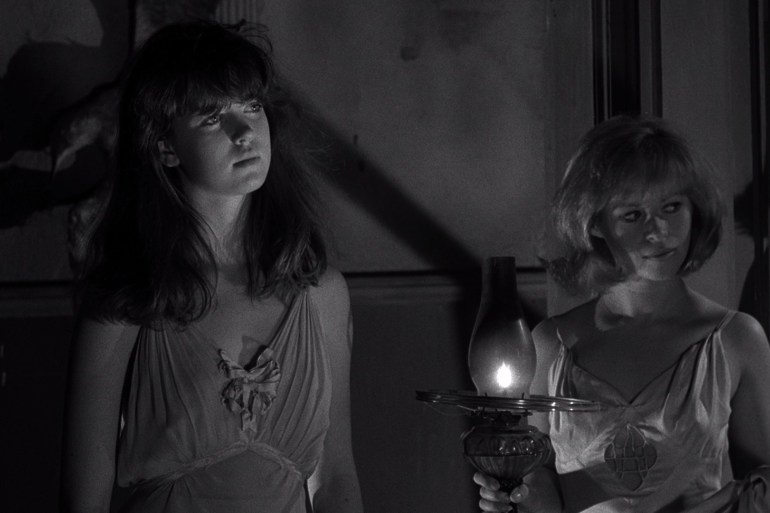Two teenage sisters, Elizabeth and Virginia, sit at a table, an unfinished jigsaw puzzle in front of them. Elizabeth idly works to piece together the puzzle. Meanwhile, Virginia stabs at the loose puzzle pieces with a large knife.
A spider crawls out from a pile of books. Virginia swiftly grabs it and eats it. “Blech. Spiders aren’t supposed to eat other spiders,” Elizabeth admonishes her.
“Cannibal spiders do,” Virginia replies, before returning to her puzzle piece stabbing.
The above is about as perfect a summary of Jack Hill’s Spider Baby as it’s possible to give, but it still doesn’t quite do justice to the wonderful strangeness of this underrated horror comedy masterpiece.
I was first introduced to Spider Baby when I was very young via a Zacherley special on VHS featuring clips from “the best of the worst” public domain horror films. The clip in question showed a hapless mailman, played by Mantan Moreland, approaching an old dark house and being brutally murdered by a young girl. It’s a silly scene, but to my young mind the juxtaposition between the silliness and the brutality of the murder made it strange and uncomfortable. I didn’t even know the name of the film, but its odd mystique stuck with me for about fifteen years before I actually watched the entire thing. When I finally did, I discovered that it’s more than just a cheesy camp horror film, and far from “the best of the worst”; it’s a genuinely well-made and entertaining film that fully deserves to be considered an oddball horror classic.
As far as I’m concerned, Spider Baby is the pinnacle of camp horror—at least of the relatively bloodless variety. It contains so many ideas that would later be used in countless hillbilly/mutant horror films, and those ideas are already fully formed in Spider Baby. But a major reason it’s unique is that in addition to predicting a popular subgenre of future horror films, it also takes many influences from earlier horror, making it a compelling “missing link” in the horror genre.
The film doesn’t take itself seriously from the first few seconds, with a foreboding yet playful theme song with amusingly grim lyrics performed by Lon Chaney Jr. and Hanna-Barbera-style cartoon caricatures of the film’s characters accompanying the opening credits. Spider Baby also doesn’t shy away from making gleeful references to older horror films, primarily the Universal horror films of the 1930s and 40s. The film even gives a direct nod to Chaney Jr.’s iconic titular performance in The Wolfman more than twenty years before: during dinner, Peter and Ann eagerly discuss their favorite horror movies and when they mention The Wolfman, Chaney Jr.’s Bruno ominously replies, “There’s going to be a full moon tonight.”
Spider Baby’s juxtaposition of classic and forward-thinking styles of horror gives it a strange and unique style. In one scene, we see Virginia eat a spider with a fork, but we also see her animalistic brother Ralph bite into what we know is a stray cat that he caught himself (and that the guests believe is a rabbit). There are jokes about Universal horror, but also multiple brutal murders and an implied rape—although virtually all of the film’s most grisly moments happen just off-screen, and it features almost no visible blood. The house is full of secret passages and dumbwaiters; on the other hand, the house also contains the rotted corpse of its patriarch lying in bed as if asleep, and Virginia even kisses it goodnight. The film looks back to the “old dark house” films of old (naturally, James Whale’s aptly titled The Old Dark House is an obvious influence), but at the same time acts as a very clear and direct precursor to the likes of The Texas Chain Saw Massacre.
Despite its silliness, the film boasts a remarkably tight script with very little going to waste simply for the sake of throwaway gags. Everything happens for a reason; for example, the mailman’s death shows us the sort of family we’re dealing with, but he also provides the letter informing Bruno of the party’s impending arrival. Later, Schlocker discovers the mailman’s severed ear that Virginia kept in a drawer, providing the first piece of undeniable proof to the guests that something is seriously wrong. Events and devices occurring later in the film are properly foreshadowed in an organic way. Unlike many schlocky camp horror films, Spider Baby is clearly a carefully written and well thought out film.
The film displays plenty of technical proficiency as well. Ronald Stein’s score is wonderfully foreboding and always suits the action on-screen. The cinematography is excellently realized by Alfred Taylor, making the most of light and shadow; perhaps the most memorable shot in the film is that of the motionless silhouettes of the two sisters at the top of the basement stairs, framed by the light of the doorway, just before they attack Schlocker. In the 2007 documentary The Hatching of Spider Baby, Sid Haig describes the impressive lengths to which Alfred Taylor went in order to properly light the scene in which Virginia murders the mailman, and that degree of dedication is evident throughout the film.
What truly puts Spider Baby above so many lesser camp horror films, however, is its heart, with Lon Chaney Jr. at its center. Every actor in the film chews scenery in a delightful manner, but Chaney Jr. brings a remarkable amount of nuance to his performance as the put-upon Bruno. One can’t help but feel for the faithful caretaker who does his best to keep the deranged but lovable family together. The characters lead the viewer to become invested in the film beyond its spooky sets and silly gags, and the fact that Spider Baby balances these disparate elements so effectively makes it a truly great film.
★★★★½


